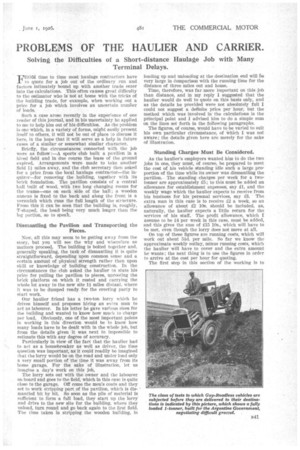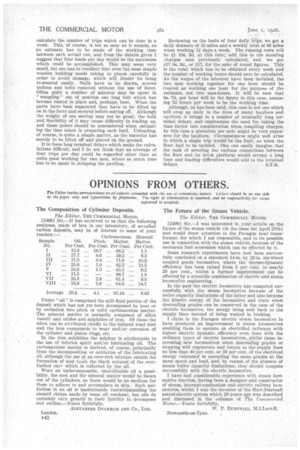PROBLEMS OF THE HAULIER AND CARRIER.
Page 55

Page 56

If you've noticed an error in this article please click here to report it so we can fix it.
Solving the Difficulties of a Short-distance Haulage Job with Many Terminal Delays.
FII.OM time to time most haulage contractors have to quote for a job out of the ordinary run and factors intimately bound up with another trade enter into the calculations. This often causes great difficulty to the estimator who is not at home with the tricks of the building trade, for example, when working out a price for a job which involves An uncertain number of loads.
Such a case arose recently in the experience of one reader of this journal, and in his uncertainty he applied to me to help him out of his difficulties. As the problem is one which, in a variety of forms, might easily present itself to others, it will not be out of place to discuss it here, in the hope that it will serve as a help in future cases of a similar or somewhat similar character.
Briefly, the circumstances connected with the job were as follow :—A sports club built a pavilion in a hired field and in due course the lease of the ground expired. Arrangements were made to take another field 14 miles away, and the club secretary then asked for a price from the local haulage contractor—the inquirer—for removing the building, together with its brick foundation. The pavilion consists of a central ball built of wood, with two long changing rooms for the teams—one on each side of the hall; a wooden annexe is fixed to the back and along the front is a verandah which runs the full length of the structure. From this it can be seen that the building is, roughly, T-shaped, the head being very much longer than the leg portion, so to speak.
Dismantling the Pavilion and Transporting the Pieces.
Now, all this may seem to be getting away from the story, but you will see the why and wherefore as matters proceed. The building is bolted together and, generally speaking, the task of dismantling it is quite straightforward, depending upon common sense and a certain ambunt of physical strength rather than upon skill or knowledge of building construction. In the circumstances the club asked the haulier to state his price for pulling the pavilion to pieces, uprooting the brick platform on which it rested and carrying the whole lot away to the new site 14 miles distant, where it was to be dumped ready for the erecting party to start work.
Our haulier friend has a two-ton lorry which he drives himself and proposes hiring an extra man to act as labourer. In his letter he gave various sizes for the building and wanted to know how much to charge per load. Obviously, one of the most important points in working in this direction would be to know how many loads have to be dealt with in the whole job, but from the details given it was next to impossible to estimate this with any degree of accuracy.
Particularly in view of the fact that the haulier had to act as a housebreaker as well as driver, the time question was important, as it could readily be imagined that the lorry would be on the road and under load only a very small portion of the time it was away from its home garage. For the sake of illustration, let us imagine a day's work on this job.
The lorry sets out with the owner and the labourer on board and goes to the field, which in this case is quite close to the garage. Off come the men's coats and they set to work stripping part of the pavilion, which is dismantled bit by bit. So soon as the pile of material is sufficient to form a full load, they start up the lorry and drive to the new site for the building, where they unload, turn round and go back again to the first field. The time taken in stripping the wooden building, in
loading up and unloading at the destination end will 5e very large in omparison with the running time for the distance of three miles out and home.
Time, therefore, was far more important on this job than distance, and in my reply I suggested that the haulier would do well to quote on this basis only, and as the details he provided were not absolutely full I could not suggest a definite price per hour, but the method which was involved in the calculations is the principal point and I advised him to do a simple sum on the lines set forth in the following paragraphs.
The figures, of course, would have to be varied to suit his own particular circumstance, of which I was not aware; the details given here are merely for the sake of illustration.
Standing Charges Must Be Considered.
As the haulier's employers wanted him to do the two jobs in one, they must, of course, be prepared to meet the cost of his vehicle standing idle such a large proportion of the time while its owner was dismantling the pavilion. The standing charges per week for a twotomer are approximately £5; to this must be added an allowance for establishment expenses, say £1, and the weekly wage which the haulier expects to receive from his business for his personal services, say £3. The extra man in this case is to receive 12 a week, so an allowance of about £2 10s. should be included, as, naturally, the haulier expects a little return for the services of his staff. The profit allowance, which I assume to be £4 per week in this case, must be added, and this gives the sum of £15 10s., which will have to be met, even though the lorry does not move at all.
On top of these figures are running costs, which will work out about 5id. per mile. So far we know the approximate weekly outlay, minus running costs, which the haulier will have to cover and the extra amount he wants; the next thing is to use the figures in order to arrive at the cost per hour for quoting.
The first step in this section of the working is to calculate the number of trips which can be done in a week. This, of course, is not so easy as it sounds, as an estimate has to be made of the working time between each actual run, and from the details given I suggest that four loads per day would be the maximum which could be accomplished. This may seem very small, but one has to recollect that even the most simple wooden building needs taking to pieces carefully in order to avoid damage, which will hinder its being re-erected easily. Nails have to be drawn, screws undone and bolts removed without the use of force. Often quite a number of minutes may be spent in " wangling" out of position one long bolt which has become rusted in place and, perhaps, bent. When the parts have been separated they have to be lifted up on to the lorry and secured before setting off. Although the weight of one section may not be great, the bulk and flexibility of it may cause difficulty in loading up, and these points should be remembered when estimating the time taken in preparing each load. Unloading, of course, is quite a simple matter, as the material has merely to be lifted off and placed on the ground.
It is these Tong terminal delays which make the calculations difficult, and I do not think that an average of four trips per day could be regarded other than as quite good working for two men, where so much time has to be spent in stripping the pavilion.
Reckoning on the basis of four daily trips, we get a daily distance of 12 miles and a weekly total of 66 miles when working 5i days a week. The running costs will be £1 10s. 3d. at this rate; add this to the standing charges sum previously calculated, and we get £17 Os. 3d., or £17, for the sake of round figures. This is the total which has to be obtained every week and the number of working hours should next be calculated. As the wages of the labourer have been included, the two men working together for one hour should be treated as working one hour for the purpose of the estimate, not two man-hours. It will be seen that 6s. 7d. per hour will be the figure in this case, assuming 52 hours per week to be the working time.
Although, as has been said, this case is not one which will crop up daily in the lives of many hauliers and carriers, it brings in a number of unusually long terminal delays, and emphasizes the need for taking the time factor into consideration when compiling charges. In this case a quotation per mile might be very expensive for the hauliers. Circumstances might well arise in which a single trip would be the limit, as when the floor had to be tackled. One can easily imagine that the task of severing the various connections between the floor and its brick platform would occupy a long time and loading difficulties would add to the terminal delays. S.T.R.


























































